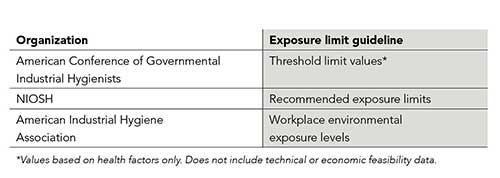Chemical exposures and PELs
Is our company at risk of litigation (i.e., employee health concerns) regarding chemical exposure in the workplace, provided we are following OSHA’s permissible exposure limits?
Responding is Michael Tesmer, safety services manager, Conney Safety – a division of Wesco Distribution Inc., Madison, WI.
OSHA permissible exposure limits are recognized as legal limits concerning exposure to chemical substances. PELs, however, are just one of many resources available to employers regarding workplace air quality.

Although employers certainly must meet OSHA PELs for compliance purposes, most safety professionals agree that the majority of OSHA-mandated levels are outdated, having originated from research conducted in the 1950s and 1960s and adopted by the agency in 1970.
OSHA has since supplemented its regulatory PELs by annotating its existing Z-Tables with more aggressive recommended limits, but it does not include limits for all chemical substances, requiring employers to look to other sources for adequate exposure limits specific to the substance in question.
Peer-reviewed occupational exposure limits are another reliable source used to determine maximum airborne concentrations of harmful substances to which a worker can be exposed over a period of time with the unlikelihood of experiencing harmful consequences. The organizations in the table above continually update their user databases; changing what they have determined to be allowable breathing limits based on the latest scientific data and research.
When searching for the exposure limit of a particular chemical compound using PEL or OEL guidelines, be aware that many chemical compounds have several different names. Therefore, employers should thoroughly investigate a chemical compound’s common name, its aliases and its chemical (or scientific) formula to ensure the correct exposure limit is identified.
By drawing from a robust OEL knowledge base and integrating more aggressive exposure limits into an air quality program, your company not only will be better positioned from both a legal and a company brand standpoint, but you will be providing your workers a greater level of health and safety.
When implementing a safety plan that will minimize worker exposure to airborne chemicals – and where respirators are determined to be the most feasible option – the following steps are recommended:
- Develop a well-written safety program.
- Monitor and document air quality data.
- Determine the respiratory protection factor based on air quality data.
- Perform medical evaluations and fit testing.
- Conduct respirator training.
- Create procedures and documentation for the maintenance and limitation(s) of select respirator(s).
- Procure respirators from a safety company with experienced safety service professionals who can assist in matching the correct respirator to the job.
For an air quality program to be effective, it is essential that management clearly understands its complexity and importance.
Post a comment to this article
Safety+Health welcomes comments that promote respectful dialogue. Please stay on topic. Comments that contain personal attacks, profanity or abusive language – or those aggressively promoting products or services – will be removed. We reserve the right to determine which comments violate our comment policy. (Anonymous comments are welcome; merely skip the “name” field in the comment box. An email address is required but will not be included with your comment.)

